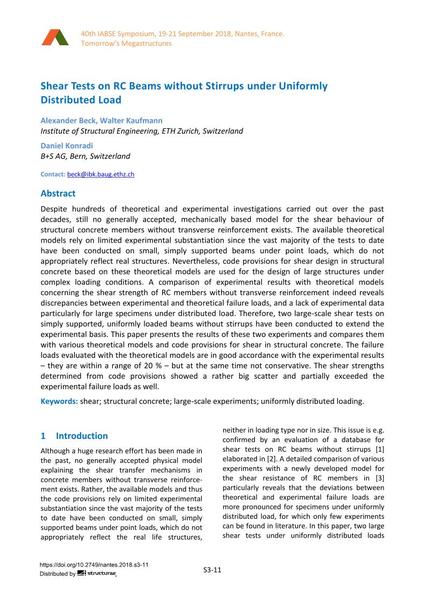Shear Tests on RC Beams without Stirrups under Uniformly Distributed Load

|
|
|||||||||||
Bibliografische Angaben
| Autor(en): |
Alexander Beck
(Institute of Structural Engineering, ETH Zurich, Switzerland)
Walter Kaufmann (Institute of Structural Engineering, ETH Zurich, Switzerland) Daniel Konradi (B+S AG, Bern, Switzerland) |
||||
|---|---|---|---|---|---|
| Medium: | Tagungsbeitrag | ||||
| Sprache(n): | Englisch | ||||
| Tagung: | IABSE Symposium: Tomorrow’s Megastructures, Nantes, France, 19-21 September 2018 | ||||
| Veröffentlicht in: | IABSE Symposium Nantes 2018 | ||||
|
|||||
| Seite(n): | S3-11 | ||||
| Anzahl der Seiten (im PDF): | 9 | ||||
| DOI: | 10.2749/nantes.2018.s3-11 | ||||
| Abstrakt: |
Despite hundreds of theoretical and experimental investigations carried out over the past decades, still no generally accepted, mechanically based model for the shear behaviour of structural concrete members without transverse reinforcement exists. The available theoretical models rely on limited experimental substantiation since the vast majority of the tests to date have been conducted on small, simply supported beams under point loads, which do not appropriately reflect real structures. Nevertheless, code provisions for shear design in structural concrete based on these theoretical models are used for the design of large structures under complex loading conditions. A comparison of experimental results with theoretical models concerning the shear strength of RC members without transverse reinforcement indeed reveals discrepancies between experimental and theoretical failure loads, and a lack of experimental data particularly for large specimens under distributed load. Therefore, two large-scale shear tests on simply supported, uniformly loaded beams without stirrups have been conducted to extend the experimental basis. This paper presents the results of these two experiments and compares them with various theoretical models and code provisions for shear in structural concrete. The failure loads evaluated with the theoretical models are in good accordance with the experimental results they are within a range of 20 % – but at the same time not conservative. The shear strengths determined from code provisions showed a rather big scatter and partially exceeded the experimental failure loads as well. |
||||
| Stichwörter: |
Schub
|
||||
